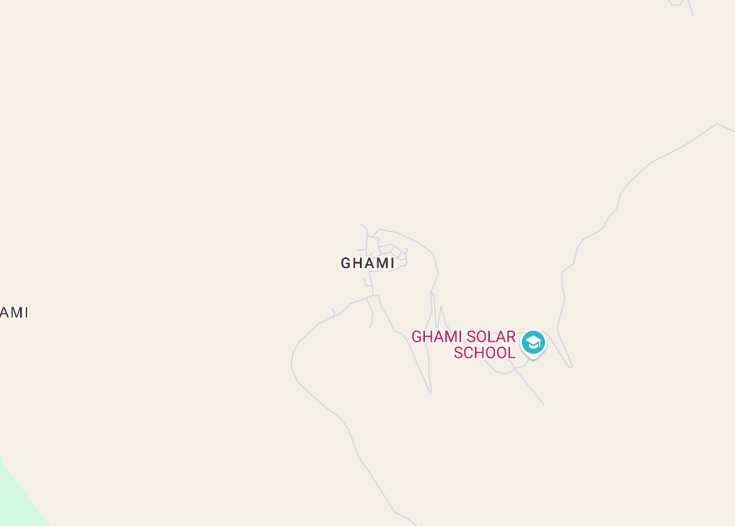Nestled in Nepal’s Mustang district, Ghami is an enchanting village that captivates with its unique blend of natural beauty and cultural richness. Surrounded by rugged mountain landscapes, this secluded village offers a peek into traditional Tibetan culture, preserved through centuries.
Ghami’s most famous attraction, the Ghami Monastery, stands amidst scenic terrains, flanked by colorful prayer flags that wave in the high-altitude breeze. Exploring Ghami provides a serene escape and an authentic experience of Nepal’s remote highland communities.
Ensure to visit during the dry months from May to October, when trails are accessible and views are unobstructed by monsoon clouds.
Engage with local guides for insights into Ghami’s history and cultural practices; their knowledge will enrich your travel experience significantly.
Top things to do & see in Ghami
Select the following sights and activities to discover best tickets and tours available in Ghami.
Ghami: A Hidden Gem in the Himalayas
| Country | Nepal |
| Time in Ghami | GMT+5:45 |
| Language spoken | Nepali |
| Population | 580 (source: Local Census 2022) |
| Currency | Nepalese Rupee (Rs, NPR) |
| Airports |
|
Ghami, a serene village in the Upper Mustang region of Nepal, is enveloped by rugged mountains and deep valleys. Historically significant, it stands on the ancient Salt Trade Route linking Tibet with Nepal, allowing a peek into the vibrant culture of the Mustang peoples. What makes Ghami particularly remarkable is its stunning arid landscape, dotted with traditional Tibetan-style houses, monasteries, and unique cliff caves.
Where is Ghami?
Ghami is nestled in the remote landscapes of the Mustang District, situated in Nepal’s northeastern region, close to the Tibetan border.
Distances:
| Route | Distance by car | Time by car |
|---|---|---|
| Kathmandu to Ghami | 400 km | 16 hours |
| Pokhara to Ghami | 260 km | 11 hours |
| Jomsom to Ghami | 60 km | 3 hours |
What is Ghami famous for?
Ghami is famed for its enchanting red cliffs and the Ghami Dhungkar Chorten, one of the most spectacular Buddhist shrines. This shrine is surrounded by a scenic panorama of barley fields, a sight uniquely typical to this part of Nepal.
History
Prehistory to 17th Century
The tale of Ghami, located deep within the Mustang region of Nepal, begins with its ancient inhabitants—nomadic tribes drawn by the valley’s promise of lush grazing grounds. This settlement, originally established as a pastoral community, slowly evolved with the introduction of Buddhism in the region around the 8th century, a transformation marked by the arrival of wandering monks.
18th Century to Establishment of Nepal (1768)
With the formation of the Nepali state under Prithvi Narayan Shah, Ghami increasingly found itself on trade routes between Nepal and Tibet. This period saw Ghami growing in economic and religious importance, as traders and pilgrims passed through the village, enhancing its cultural and commercial vibrancy.
19th Century to Modern Day
In the 19th century, Ghami became a critical juncture along the salt trade route, also known as the Salt Road. As globalization began in the 20th century, Ghami retained its picturesque charm and traditional lifestyle despite increased connectivity. Today, it is celebrated not only for its historical depth but also for its preserved Tibetan Buddhist heritage, seen in the ornate monasteries and vibrant religious festivals.
Visit Ghami
What to see and do in Ghami, Nepal.
Ghami invites travelers to immerse themselves in an authentically preserved Tibetan culture. Key sights include:
- The Ghami Monastery with its elaborate wall paintings and ancient scrolls.
- The Royal Palace, a testament to the village’s past significance.
- Scenic hiking trails that include vistas of the Himalayan peaks and valley views.
Engage in guided tours to nearby caves and participate in meditation sessions at local monasteries for a holistic experience.
Annual Celebrations in Ghami
Ghami hosts vibrant festivals throughout the year, rooted in Tibetan Buddhism. Highlights include:
- The ‘Tiji Festival’ in May, featuring masked dances and rituals that signify the triumph of good over evil.
- The ‘Harvest Festival’ in September, celebrating the bounteous produce of the region.
These events reflect the spiritual and agrarian calendar of the community, offering visitors a profound insight into local traditions.
Best time to visit Ghami
The ideal periods to visit Ghami are during the months of April to June and September to November. These months offer pleasant weather, clear sky views, and the opportunity to partake in local festivals.
Is Ghami worth visiting?
Ghami is undoubtedly worth visiting for those intrigued by history, culture, and nature’s marvels. This serene village not only offers a peek into the authentic Tibetan lifestyle but also serves as a gateway to exploring the majestic landscapes of the Mustang region.
Its historical sites, spiritual centers, and the warm hospitality of its people provide a deeply enriching experience that resonates long after the visit.










